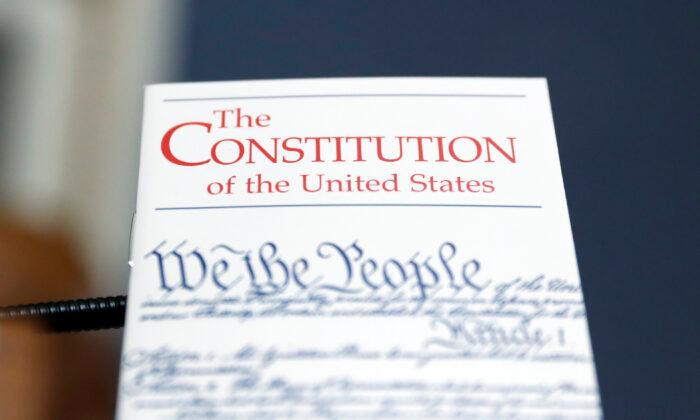By respecting the understanding behind a document, originalism keeps the document alive.
By contrast, there’s no simple definition of “living constitutionalism” because “living constitutionalists” differ greatly among themselves. They’re united by dislike of many of the Constitution’s rules and standards, and they all want to adjust the Constitution to serve their political goals. But beyond that, their unity ends: They sometimes have different goals, and they propose different ways of justifying constitutional manipulation.
“Living constitutionalism” is a misnomer, because when we abandon a document’s rules and standards, the document dies. In practice, “living constitutionalism” converts our Constitution into a parchment loincloth to cover political pudenda.
The “too vague” and “too rigid” accusations are not only inconsistent with each other, they also are incorrect.
Let’s apply a dash of common sense to a serving of history. The Constitution’s framers weren’t the kind of people who write overly rigid or meaningless terms. They included Oliver Ellsworth of Connecticut, John Dickinson of Delaware, and John Rutledge of South Carolina, each the leading attorney in his respective state. Eight framers had been educated in London’s Inns of Court, the schools for training English barristers. The framers included other celebrated lawyers as well, such as James Wilson of Pennsylvania and Alexander Hamilton of New York.
Even most of the non-lawyers, such as James Madison and Nathaniel Gorham, had been immersed in legal subjects throughout their careers. The framers had composed written legal documents in business, in law practice, in the state legislatures, and in Congress.
They were, moreover, deeply familiar with the 600-plus-year Anglo-American tradition of composing constitutional-style documents.
They drafted the Constitution as a legal document should be drafted: tuning each provision to the level of rigidity or flexibility necessary to its purpose.
- The president “shall hold his Office during the Term of four Years.”
- “No Person shall be convicted of Treason unless on the Testimony of two Witnesses to the same overt Act, or on Confession in open Court.”
- “The president shall hold [insert politically correct pronoun here] office as long as the judges, balancing all factors, decide it promotes good social policy,” and
- “A person may be convicted of treason if the judges find the evidence persuasive after they have balanced its reliability and quantity with the needs of social justice.”
- “Each House shall keep a Journal ... and from time to time publish the same, excepting such Parts as may in their Judgment require Secrecy,” and
- “The Privilege of the Writ of Habeas Corpus shall not be suspended, unless when in cases of rebellion or invasion the public safety may require it.”
One reason some people think the Constitution is too vague or too rigid is that they don’t understand what many of its clauses actually mean.
For example, some law professors used to laugh at how “rigid” the coinage clause is. The coinage clause (Article I, Section 8, Clause 5) grants Congress power “To coin Money, regulate the Value thereof, and of foreign Coin, and fix the Standard of Weights and Measures.” The scoffers assumed that “To coin Money” meant only to strike metallic coin. They said that in modern society, this is impractical: We need paper and electronic money as well.
But if they'd read the clause carefully, they might have noticed that interpreting “coin” as only metal made no sense. When the Constitution says “regulate the Value ... of foreign Coin,” it means setting foreign exchange rates. If “Coin” meant only metal, then Congress could set exchange rates for foreign metal tokens but not for foreign paper money. Surely the Founders couldn’t have intended such an absurd interpretation.
The living-Constitution crowd leveled the opposite accusation against the necessary and proper clause (Article I, Section 8, Clause 18). They claimed it was so open-ended that they branded it the elastic clause.
The necessary and proper clause grants Congress the power “to make all Laws which shall be necessary and proper for carrying into Execution the foregoing Powers, and all other Powers vested by this Constitution in the Government of the United States, or in any Department or Officer thereof.”
“What in the world does ‘necessary and proper’ mean?” the scoffers asked. “And what about these powers ‘in the Government of the United States’? Is that a drafting mistake? The Constitution grants powers to government departments and officers, but not to ‘the Government of the United States.’” Some living constitutionalists have even claimed it refers to federal authority not otherwise mentioned in the Constitution.
Most constitutional commentators have had little experience practicing law. But I have, and to me, the necessary and proper clause looked like a phrase I’d seen in agency and trust documents. I suspected “necessary and proper” was a common term in 18th-century documents and had a specific meaning.
Investigation proved my hunch. During the Founding Era, “necessary and proper” and variants of that phrase were exceedingly common in legal documents. In this context, “necessary” was a technical term for “incidental,” and “proper” meant “in compliance with fiduciary duty.” I don’t have space here to explain all of these legal expressions, but I can assure you they’re not “vague.”
The necessary and proper clause authorized Congress to undertake a limited number of subordinate activities the Constitution doesn’t list explicitly. My investigation also showed that the Supreme Court had misapplied the clause in some very important cases.
I also found—contrary to what the scoffers were saying—that the part of the clause referring to powers granted to “the Government of the United States” wasn’t a drafting error or a reference to mysterious extra-constitutional authority. The Constitution explicitly grants some powers to the federal government as an entity. This last point became clear from examining colonial documents familiar to the framers but unknown to most commentators.
Of course, altered conditions occasionally do require constitutional change. To respond, we can use the amendment process. We don’t need to kill the Constitution on the pretense of letting it live.





